| Revision as of 14:00, 14 July 2013 edit178.149.76.148 (talk) →Given names← Previous edit | Revision as of 06:06, 12 August 2013 edit undoFyunck(click) (talk | contribs)Extended confirmed users, Pending changes reviewers63,734 edits direct linkNext edit → | ||
| Line 221: | Line 221: | ||
| Serbian men's and women's teams are also World Champions in sports such as water polo and volleyball. | Serbian men's and women's teams are also World Champions in sports such as water polo and volleyball. | ||
| Serbian tennis players have been successful. The no. 1 men's tennis player in the World is ], with a record of winning five Grand Slam Singles titles. ], ], ] and ] are also successful. The ] won the ] Final held in the ]. | Serbian tennis players have been successful. The no. 1 men's tennis player in the World is ], with a record of winning five Grand Slam Singles titles. ], ], ] and ] are also successful. The ] won the ] Final held in the ]. | ||
| ==Cultural institutions== | ==Cultural institutions== | ||
Revision as of 06:06, 12 August 2013
| Part of a series on the |
| Culture of Serbia |
|---|
 |
| History |
| People |
| Languages |
| Traditions |
| Mythology and folklore |
| Cuisine |
| Festivals |
| Religion |
| Art |
| Literature |
| Music and performing arts |
| Media |
| Sport |
| Monuments |
| Symbols |
| Organisations |
Serbian culture refers to the culture of Serbia and of ethnic Serbs.
Serbian culture starts with that of the South Slavic peoples that lived in the Balkans. Early on, Serbs may have been influenced by the Paleo-Balkan peoples. The Byzantine Empire had a great influence on the culture; Serbs were initially governing the Byzantine frontiers in the name of the emperor and were later through their sworn alliance given independence, baptized by Greek missionaries and adopted the Cyrillic script. The Serbian Orthodox Church gained autocephaly from Constantinople in 1219. The Republic of Venice influenced the maritime regions in the Middle Ages. The Ottoman Empire conquered Serbia in 1459 and placed the country under a state of occupation which lasted for four centuries, the consequences of which suppressed Serbian culture but also greatly influenced Serbian Art. Serbian culture flourished from 1718 in regions that were under the control of the Habsburg Monarchy.
Following Serbia's autonomy after the Serbian revolution and eventual independence, the culture of Serbia was restrengthened within its people.
Life
Religion
Main article: Religion in Serbia See also: Serbian Orthodox Church
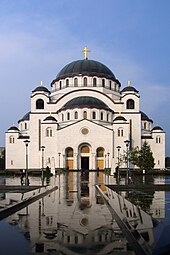
Conversion of the South Slavs from Paganism to Christianity began in the early 7th century, long before the Great Schism, the split between the Greek Orthodox East and the Roman Catholic West, the Serbs were first Christinaized during the reign of Heraclius (610-641) but were fully Christianized by Byzantine Christian Missionaries (Saints) Cyril and Methodius in 869 during Basil I, who sent them after Knez Mutimir, had acknowledged the suzerainty of the Byzantine Empire. After the Schism, those who lived under the Byzantine sphere of influence became Orthodox and those who lived under the Roman sphere of influence became Catholic. Later, with the arrival of the Ottoman Empire, many Serbs converted to Islam. Their modern descendants are considered to be members of the Gorani and Bosniak ethnic groups.

The Serbian Orthodox Church was the westernmost bastion of Orthodox Christianity in Europe, which shaped its historical fate through contacts with Catholicism and Islam.
During World War II, the Serbs, living in a wide area, were persecuted by various peoples and organizations. The Catholic Croats under the Fascist Ustaša regime, recognized the Serbs only as "Croats of the Eastern faith" and had the ideological vision that 1/3 of the Serbs were to be murdered, 1/3 were to be converted and the last third expelled. The outcome of these visions was the death of at least 700,000 people, the religious conversion of 250,000 and the expulsion of 250,000.
Names
Main article: Serbian nameGiven names
As with most Western cultures, a child is given a first name chosen by their parents but approved by the godparents of the child (the godparents usually approve the parent's choice). The given name comes first, the surname last, e.g. "Željko Popović", where "Željko" is a first name and "Popović" is a family name. Female names end with -a, e.g. Dragan -> Dragana.
Popular names are mostly of Serbian (Slavic), Christian (Biblical), Greek and Latin origin.
- Serbian: Dragan, Zoran, Goran and Slobodan.
- Greek: Nikola, Đorđe, Aleksandar and Katarina.
- Biblical: Petar, Pavle, Mihailo and Gavrilo.
- Latin: Marko, Srđan, Antonije and Roman.
Surnames
Most Serbian surnames (like Bosnian, Croatian and Montenegrin) have the surname suffix -ić (pronounced , Cyrillic: -ић). This is often transliterated as -ic or -ici. In history, Serbian names have often been transcribed with a phonetic ending, -ich or -itch. This form is often associated with Serbs from before the early 20th century: hence Milutin Milanković is usually referred to, for historical reasons, as Milutin Milankovitch.
The -ić suffix is a Slavic diminutive, originally functioning to create patronymics. Thus the surname Petrić signifies little Petar, as does, for example, a common prefix Mac ("son of") in Scottish & Irish, and O' (grandson of) in Irish names. It is estimated that some two thirds of all Serbian surnames end in -ić but that some 80% of Serbs carry such a surname with many common names being spread out among tens and even hundreds of non-related extended families.
Other common surname suffixes are -ov or -in which is the Slavic possessive case suffix, thus Nikola's son becomes Nikolin, Petar's son Petrov, and Jovan's son Jovanov. Those are more typical for Serbs from Vojvodina. The two suffixes are often combined.
The most common surnames are Marković, Nikolić, Petrović, and Jovanović.
Cuisine
| This section needs expansion. You can help by adding to it. (October 2010) |
Most people in Serbia will have three meals daily, breakfast, lunch and dinner, with lunch being the largest and most important meal. However, traditionally, only lunch and dinner existed, with breakfast being introduced in the second half of the 19th century.


Background
Traditional Serbian cuisine is varied and can be said to be a mix of central European, Mediterranean and Middle Eastern cuisine. Ćevapčići consisting of grilled heavily seasoned mixed ground meat patties is considered to be the national dish. Other notable dishes include Koljivo used in religious rituals, Serbian salad, Sarma (stuffed cabbage), podvarak (roast meat with sauerkraut) and Moussaka. Česnica is a traditional bread for Christmas Day.
Homemade meals
A number of foods which are simply bought into Supermarkets from the West, are often made at home in Serbia. These include rakija (fruit brandy), slatko, jam, jelly, and pickled foods (notably sauerkraut, ajvar and sausage). The reasons for this range from economical to cultural. Food preparation is a strong part of the Serbian family tradition.

Desserts
Serbian desserts are a mixture of other Balkan desserts and desserts native to central Serbia. Desserts served are usually Uštipci, Tulumbe, Krofne and Palačinke (crepes). Slatko is a traditional Serbian dessert popular throughout Serbia and it can be found in most Serbian restaurants in the Balkans and in the diaspora.
Drinks
Beer is widely consumed in Serbia. The most popular brands are Jelen Pivo and Lav Pivo. Rakija, a plum brandy commonly known by popular brand name Slivovitz is a distilled fermented plum juice. This is the national drink of Serbia with 70% of domestic plum production being used to make it. Domestic wine is also popular. Turkish coffee is widely consumed as well.
Language
Main article: Serbian language
Serbs speak the Serbian language, a member of the South Slavic group of languages, specifically in the Southwestern Slavic group with the Southeastern Slavic languages including Macedonian and Bulgarian. It is mutually intelligible with the standard Croatian and Bosnian language (see Differences in standard Serbian, Croatian and Bosnian) and some linguists still consider it part of the pre-war Serbo-Croatian language.
The Serbian language comprises several dialects, the standard language is based on the Stokavian dialect.
It is an official language in Serbia, Bosnia and Herzegovina and Montenegro. In Hungary, Slovakia, Croatia, the Macedonia and Romania, it is a regionally recognized minority language.
There are several variants of the Serbian language. The older forms of Serbian are Old Serbian and Russo-Serbian, a version of the Church Slavonic language.

Serbian is the only European language with active digraphia, using both Cyrillic and Latin alphabets. Serbian Cyrillic alphabet was devised in 1814 by Vuk Karadžić, who created the alphabet on phonemic principles, the Cyrillic itself has its origins in Cyril and Methodius transformation from the Greek script.
Loanwords in the Serbian language are mostly from Turkish, German and Italian, words of Hungarian origin is present mostly in the north and Greek words mostly in the liturgy.
Two Serbian words that are used in many of the world's languages are vampire and paprika. Slivovitz and ćevapčići are Serbian words which have spread together with the Serbian food/drink they refer to. Paprika and Slivovitz are borrowed via German; paprika itself entered German via Hungarian. Vampire entered most West European languages through German-language texts in the early 18th century and has since spread widely in the world.
Literature
Main article: Serbian literatureMiroslav's Gospel is one of the earliest works of Serbian literature dating from between 1180 and 1191 and one of the most important works of the medieval period. This work was entered into UNESCO's Memory of the World program in 2005. Serbian epic poetry was a central part of medieval Serbian literature based on historic events such as the Battle of Kosovo.
In the 20th century, Serbian literature flourished and a myriad of young and talented writers appeared.
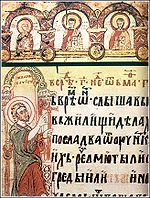
The most well known authors are Ivo Andrić, Miloš Crnjanski, Meša Selimović, Borislav Pekić, Danilo Kiš, Milorad Pavić, David Albahari, Miodrag Bulatović, Dobrica Ćosić, Zoran Živković and many others. Jelena Dimitrijević and Isidora Sekulić are two early 20th century women writers. Svetlana Velmar-Janković is the best known female novelist in Serbia today.
Andrić's novel The Bridge on the Drina won the Nobel Prize for Literature in 1961.
Milorad Pavić is perhaps the most widely acclaimed Serbian author today, most notably for his Dictionary of the Khazars (Хазарски речник/Hazarski Rečnik), which has been translated into 24 languages.
Traditions and customs
Main article: Serbian traditionsSerbs have many traditions. The Slava is exclusive custom of the Serbs, each family has one patron saint that they venerate on their feast day. The Serbian Orthodox Church uses the traditional Julian Calendar, as per which Christmas Day (December 25) falls currently on January 7 of the Gregorian Calendar, thus the Serbs celebrate Christmas on January 7, shared with the Orthodox churches of Jerusalem, Russia, Georgia, Ukraine and the Greek Old Calendarists.
- Slava, Serbian Orthodox Patron saint veneration
- Kumstvo, God-parenthood in the Serbian Orthodox Church
- Pobratimstvo, blood-brotherhood
- Kolo, Serbian folk dance in circle.
- Serbian Christmas traditions
- Badnjak (Serbian), Christmas tradition
- Serbian epic poetry, Epic poetry
The Serbs are a highly family-oriented society. A glance into a Serbian dictionary and the richness of their terminology related to kinship speaks volumes.

Of all Slavs and Orthodox Christians, only Serbs have the custom of slava. The Slava is the celebration of a family's patron saint; unlike most customs that are common for the whole people, each family separately celebrates its own saint (of course, there is a lot of overlap) who is considered its protector. A slava is inherited, mostly, though not exclusively from father to son (if a family has no son and a daughter stays in parental house and her husband moves in, her Slava, not his, is celebrated). Each household has only one saint it celebrates, which means that the occasion brings all of the family together. However, since many saints (e.g. St. Nicholas, St. John the Baptist, St. George, St. Archangels of Gabriel and Michael, and the Apostles St. Peter and Paul) have two feast days, both are marked.
The traditional dance is a circle dance called kolo, which is common among Serbs, Montenegrins and Macedonians. It is a collective dance, where a group of people (usually several dozen, at the very least three) hold each other by the hands or around the waist dancing, forming a circle (hence the name), semicircle or spiral. It is called Oro in Montenegro. Similar circle dances also exist in other cultures of the region.

Serbs have their own customs regarding Christmas. The Serbian Orthodox Church uses the Julian calendar, so Christmas currently falls on January 7 of the Gregorian calendar. Early in the morning of Christmas Eve, the head of the family would go to a forest in order to cut badnjak, a young oak, the oak tree would then be brought into the church to be blessed by the priest. Then the oak tree would be stripped of its branches with combined with wheat and other grain products would be burned in the fireplace. The burning of the badnjak is a ritual which is most certainly of pagan origin and it is considered a sacrifice to God (or the old pagan gods) so that the coming year may bring plenty of food, happiness, love, luck and riches. Nowadays, with most Serbs living in towns, most simply go to their church service to be given a small parcel of oak, wheat and other branches tied together to be taken home and set afire. The house floor and church is covered with hay, reminding worshippers of the stable in which Jesus was born.
Christmas Day itself is celebrated with a feast, necessarily featuring roasted piglet as the main meal. The most important Christmas meal is česnica, a special kind of bread. The bread contains a coin; during the lunch, the family breaks up the bread and the one who finds the coin is said to be assured of an especially happy year.
Christmas is not associated with presents like in the West, although it is the day of Saint Nicholas, the protector saint of children, to whom presents are given. However, most Serbian families give presents on New Year's Day. Santa Claus (Deda Mraz (literally meaning Grandpa Frost)) and the Christmas tree (but rather associated with New Year's Day) are also used in Serbia as a result of globalisation. Serbs also celebrate the Old New Year (currently on January 14 of the Gregorian Calendar).
On Orthodox Easter, Serbs have the tradition of Slavic Egg decorating.
Another related feature, often lamented by Serbs themselves, is disunity and discord; as Slobodan Naumović puts it, "Disunity and discord have acquired in the Serbian popular imaginary a notorious, quasi-demiurgic status. They are often perceived as being the chief malefactors in Serbian history, causing political or military defeats, and threatening to tear Serbian society completely apart." That disunity is often quoted as the source of Serbian historic tragedies, from the Battle of Kosovo in 1389 to Yugoslav wars in 1990s. Even the contemporary notion of "two Serbia's"—one supposedly national, liberal and Eurocentric, and the other conservative, nationalist and Euroskeptic—seems to be the extension of the said discord. Popular proverbs "two Serbs, three political parties" and "God save us from Serbs that may unite!", and even the unofficial Serbian motto "Only Unity Saves the Serbs" (Samo sloga Srbina spasava) illustrate the national frustration with the inability to unite over important issues.
Humour
Serbian humour is centuries old. The most common type of humour is Black Humour and Serbian jokes are often imitated by other peoples from the Balkans, often with a twist. As with many other peoples, there are popular stereotypes on the local level: in popular jokes and stories, inhabitants of Vojvodina (Lale) are perceived as phlegmatic, undisturbed and slow; Montenegrins are lazy and pushy; southern Serbians are misers; Bosnians are raw and stupid; people from Central Serbia are often portrayed as capricious and malicious, etc. But all that is pure conjecture, of course.
Serb folklore
Main article: Serbian folklore- Slavic mythology, pagan folklore
- Serbian epic poetry
In Krajište and Vlasina there are epic stories of the extermination of Roman males in a battle, and of the settling of Russians (Antes)
Serbian visual arts
Main article: Serbian art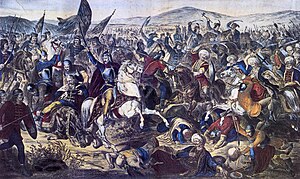
The Ottoman conquest of Serbia during the 15th century is traditionally said to have had a negative impact of the visual arts. The church was not subdued to the Greek Orthodox Patriarchate at Constantinople and the nobility was suppressed. As the nobility and church were the main sources of patronage for architects and artists, the early modern period is considered an artistically less productive period in the art of Serbia. Despite the general trend, remarkable monuments were built.
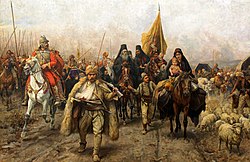
There was some resumption of artistic endeavour after the restoration of the Serbian patriarch in 1557. Djordje Mitrofanović was the leading painter of the early 17th century with his work on the church at the Morača Monastery considered as amongst his best. The Husein-Pasha Mosque in Pljevlja (Montenegro) is the most notable Muslim structure in the Balkans and dates from the middle of the 16th century.

A "Baroque" church 'Our Lady of the Rocks' on an island in the Boka Kotorska, in Montenegro is one of the most notable pieces of architecture in the Serbian lands from the early modern period. There are many fine specimens of silverware dating from the 17th century there. Traditional Serbian art was beginning to show some Baroque influences at the end of the 18th century as shown in the works of Nikola Nešković, Teodor Kračun and Jakov Orfelin.
There was somewhat of a resurgence in Serbian art in the 19th century as Serbia gradually regained its autonomy. Prince Aleksandar commissioned the building of a Monument to the Insurgents in Karađorđev Park in 1848 in Vračar. Serbian paintings showed the influence of Neoclassicism and Romanticism during the 19th century. Anastas Jovanović was a pioneering photographer in Serbia taking the photos of many leading citizens.
Kirilo Kutlik set up the first school of art in Serbia in 1895. Many of his students went to study in Western Europe, especially France and Germany and brought back avant-garde styles. Nadežda Petrović was influenced by Fauvism while Sava Šumanović worked in Cubism.
After World War I, the Belgrade School of Painting developed in the capital with some members such as Milan Konjović working in a Fauvist manner, while others such as Marko Čelebonović working in a style called Intimisme based on the use of colours.
The most famous Serbian painters were Paja Jovanović and Uroš Predić, painting in the Realist style. Their monumental paintings of historical events have inspired generations of Serbian artists.
Serbian performing arts
Music
Main article: Music of Serbia
Marija Šerifović won first place at the 2007 Eurovision Song Contest, and Serbia was the host of the 2008 contest.
Serbian music dates from the medieval period with strong church and folk traditions. Church music in Serbia of the time was based on the Osmoglasnik a cycle of religious songs based on the resurrection and lasting for eight weeks. During the Nemanjić dynasty and under other rulers such as Stefan Dušan, musicians enjoyed royal patronage. There was a strong folk tradition in Serbia dating from this time.
During Ottoman rule, Serbs were forbidden to own property, to learn to read and write and denied the use of musical instruments. Church music had to be performed in private. Gusle, a one-stringed instrument, was invented by Serbian peasants during this time in an effort to find a loophole through the stringent Ottoman laws. Filip Višnjić was a particularly notable guslar (gusle player). In the 18th century, Russian and Greek chant schools were established and the Serbian Orthodox Church accepted Church Slavonic into their liturgy.
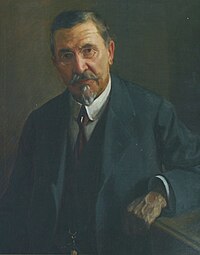
Folk music enjoyed a resurgence in the nineteenth century. Jozip Slezenger founded the Prince's Band playing music based on traditional tunes. Stevan Mokranjac, a composer and musicologist collected folk songs as well as performing his own work. Kornelije Stankovic wrote the first Serbian language works for choirs.
Traditional Serbian folk music remains popular today especially in rural areas. Western rock and pop music has become increasingly popular especially in cities with rock acts such as Riblja Čorba and Đorđe Balašević incorporating political statements in their music. Turbo-folk combined Western rock and pop styles with traditional folk music vocals. Serbian immigrants have taken their musical traditions to nations such as the US and Canada.
Theatre and cinema
Main article: Cinema of SerbiaSerbia has a well-established theatrical tradition with many theatres. The Serbian National Theatre was established in 1861 with its building dating from 1868. The company started performing opera from the end of the 19th century and the permanent opera was established in 1947. It established a ballet company.
Bitef, Belgrade International Theatre Festival, is one of the oldest theatre festivals in the world. New Theatre Tendencies is the constant subtitle of the Festival. Founded in 1967, Bitef has continually followed and supported the latest theater trends. It has become one of five most important and biggest European festivals. It has become one of the most significant culture institutions of Serbia.
Cinema was established reasonably early in Serbia with 12 films being produced before the start of World War II. The most notable of the prewar films was Mihailo Popovic's The Battle of Kosovo in 1939.

Cinema prospered after World War II. The most notable postwar director was Dušan Makavejev who was internationally recognised for Love Affair: Or the Case of the Missing Switchboard Operator in 1969 focusing on Yugoslav politics. Makavejev's Montenegro was made in Sweden in 1981. Zoran Radmilović was one of the most notable actors of the postwar period.
Serbian cinema continued to make progress in the 1990s and today despite the turmoil of the 1990s. Emir Kusturica won two Golden Palms for Best Feature Film at the Cannes Film Festival, for When Father Was Away on Business in 1985 and then again for Underground in 1995. In 1998, Kusturica won a Silver Lion for directing Black Cat, White Cat.
As at 2001, there were 167 cinemas in Serbia (excluding Kosovo) and over 4 million Serbs went to the cinema in that year. In 2005, San zimske noći (A Midwinter Night's Dream ) directed by Goran Paskaljević caused controversy over its criticism of Serbia's role in the Yugoslav wars in the 1990s.
Serbian handcrafts
Serbia has a long tradition of handicrafts. Đakovica in Kosovo was known for its black pottery. Pirot in eastern Serbia became known for its ceramics under the Ottomans with the potters following Byzantine designs. It also became a centre for the production of Kilims or rugs.
The Slavs introduced jewellery making to Serbia in the sixth century AD. Metalworking started to develop on a significant scale following the development of a Serbian state. Workshops were set up in towns, large estates and in monasteries. The Studenica Monastery was known for the quality of its goldsmithing. Coins were minted not only by the kings but some of the wealthier nobility. The nobility also was influenced by the wealth of the Byzantine court. Metalworking like many other arts and crafts went into decline following the Ottoman conquest. However, there was a partial revival in later centuries with a strong Baroque influence notably the 17th century silverwear at "Our Lady on the Rocks" on Boka Kotorska.
Serbian media
As of 2001, there were 27 daily newspapers and 580 other newspapers published in Serbia. Some of these newspapers have Internet editions. Politika founded in 1904 is the oldest daily newspaper in the Balkans. There were also 491 periodical magazines published in Serbia with the Nedeljne informativne novine (NIN) and Vreme amongst the most notable.
Television broadcasting started in 1958 with every country in the former Yugoslavia having its own station. In Serbia, the state television station was known as RTB and became known as RTS after the breakup of Yugoslavia. Under the Communists and Milošević regime, state broadcasting was controlled by the ruling party. The RTS station was bombed during the NATO action against the Milošević regime due to its propaganda role under that regime.
There was some private broadcasting with the B92 radio and television station starting in 1989 although it was shut down in 1999 during the hostilities. After the fall of Milošević, RTS became known as Nova RTS as an assertion of independence while B92 commenced broadcasting. During 2001, there were 70 television centres in Serbia of which 24 were privately owned. In 2003, there was a return to censorship as the Government of Zoran Živković temporarily imposed a state of emergency following the assassination of Zoran Djindjic and the European Federation of Journalists continues to hold concerns over media freedom in the country.
Sport
Main article: Sport in Serbia
Serbia is very successful in many sports. Among the most popular sports are football, basketball, water polo, handball, volleyball and tennis.
The two most popular football clubs in Serbia are Red Star Belgrade and FK Partizan. Their supporters are the Delije and the Grobari, respectively. The Serbian national football team participated in the 2010 FIFA World Cup.
In basketball, Serbian clubs are successful and participate regularly in European competitions, where they often make quarter-final and semi-final appearances. The Serbian national basketball team is successful in international competitions, having won several FIBA World Championship, EuroBasket and Olympic gold medals.
Serbian men's and women's teams are also World Champions in sports such as water polo and volleyball.
Serbian tennis players have been successful. The no. 1 men's tennis player in the World is Novak Djoković, with a record of winning five Grand Slam Singles titles. Janko Tipsarević, Viktor Troicki, Jelena Janković and Ana Ivanovic are also successful. The Serbia Davis Cup team won the 2010 Davis Cup Final held in the Belgrade Arena.
Cultural institutions
At the beginning of the 21st century, there were 32 art galleries and 142 museums in Serbia. Belgrade has many of the most significant with the National Museum of Serbia in Belgrade, the Gallery of Frescoes featuring Orthodox Church art, the Ethnographic Museum and the Princess Ljubica's Residence. Novi Sad contains the Vojvodina Museum as well as the Petrovaradin fortress.
Matica Srpska is the oldest and most notable cultural and scientific organisation in today's Serbia. Its name is translated in Serbian as the Serbian matrix or parent body of the Serbs. It was founded in 1826 in Budapest and moved to Novi Sad in 1864. Amongst other achievements, it compiled a six-volume study of the Serbian language between 1967 and 1976. Its journal Letopis Matice Srpske is one of the oldest periodicals examining scientific and cultural issues anywhere in the world. Vojvodina province of Austro-Hungary became attractive for Serbs ever since the fall of Serbia in 15th century, and was the site of the Great Serbian Migrations, when Serbs colonized the area escaping Turkish vengeance. Sremski Karlovci became the spiritual, political and cultural centre of the Serbs in the Habsburg Empire, with Metropolitan of the Serbian Orthodox Church residing in the town. To this day, the Patriarch of Serbia retains the title of Metropolitan of (Sremski) Karlovci. The town featured the earliest Serb and Slavic grammar school (Serbian: gimnazija/гимназија, French: Lycée) founded on August 3, 1791. In 1794, an Orthodox seminary was also founded in the town, ranking second oldest in the world (after the Spiritual Academy in Kiev). Novi Sad is home to Serbia's oldest professional theatre, founded in 1861 as Srpsko Narodno Pozoriste, followed by Belgrade in 1868; however two other cities claim this title: City of Kragujevac Knjazesko Srbski Teatar since 1835 and Subotica since 1851 (*there were theatres throughout Serbia long before that time but cannot be classified as "professional".
There is a network of libraries with three national libraries, 689 public libraries, 143 higher education libraries and 11 non-specialised libraries as at 1998. The National Library of Serbia is the most significant of these. Project Rastko founded in 1997 is an Internet library of Serb culture.
Roots to the Serbian education system date back to 11th and 12th centuries when first Catholic colleges were founded in Vojvodina (Titel, Bac). Medieval Serbian education however was mostly conducted through the Serbian Orthodox monasteries (UNESCO protected Sopoćani, Studenica, Patriarchate of Peć) starting from the rise of Raška in 12th century, when Serbs overwhelmingly embraced Orthodoxy rather than Catholicism. The first European-style higher education facilities however were founded in Catholic Vojvodina, Teacher's College in Subotica in 1689, although several facilities have functioned even before (e.g. Jesuit School in Belgrade, since 1609). Following short-lived Serbian independence between 1804 and 1813, Belgrade officially became an educational centre of the country (excluding Vojvodina). The University of Belgrade is the biggest and most prestigious institution of higher education in Serbia, founded as the Belgrade Higher School in 1808. The Gymnasium Jovan Jovanović Zmaj was founded in 1810 and many important Serb cultural figures studied there.
Within the Government of Serbia, the Serbian Ministry for Culture is responsible for administering its cultural facilities.
National symbols

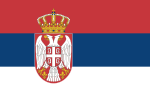
- The Serbian flag is a red-blue-white horizontal tricolour.
- The Serbian eagle, a white two-headed eagle, which represents dual power and sovereignty (monarch and church), was the coat of arms of the Nemanjić dynasty.
- The Serbian cross is based on the Byzantine cross, but where the Byzantine Cross held 4 Greek letter 'V' (or 'B') meaning King of Kings, ruling over Kings, the Serbian cross turned the Byzantine "B" into 4 Cyrillic letters of 'S' (C) with little stylistic modification, for a whole new message (traditionally rendered as Samo sloga Srbina spasava). If displayed on a field, traditionally it is on red field, but could be used with no field at all.
Both the eagle and the cross, besides being the basis for various Serbian coats of arms through history, are bases for the symbols of various Serbian organizations, political parties, institutions and companies.
Serbian folk attire varies, mostly because of the very diverse geography and climate of the territory inhabited by the Serbs. Some parts of it are, however, common:
- A traditional shoe that is called the opanak. It is recognizable by its distinctive tips that spiral backward. Each region of Serbia has a different kind of tips.
- A traditional hat that is called the Šajkača. It is easily recognizable by its top part that looks like the letter V or like the bottom of a boat (viewed from above), after which it got its name. It gained wide popularity in the early 20th century as it was the hat of the Serbian army in the First World War. It is still worn everyday by some villagers today, and it was a common item of headgear among Bosnian Serb military commanders during the Bosnian War in the 1990s. However, the "Šajkača" is common mostly for the Serbian population living in the region of Central Serbia (Šumadija), while Serbs living in Vojvodina, Montenegro, Bosnia and Herzegovina, and Croatia had different types of traditional hats, which are not similar to "šajkača". Different types of traditional hats could be also found in eastern and southern parts of Central Serbia.
See also
References
| This article includes a list of general references, but it lacks sufficient corresponding inline citations. Please help to improve this article by introducing more precise citations. (April 2009) (Learn how and when to remove this message) |
- Antonić, Dragomir (2006-07-23). "Царство за гибаницу". Politika 33300 (in Serbian). Politika. p. 11.
- Slobodan Naumović. "The social origins and political uses of popular narratives on Serbian disunity" (PDF). Filozofija i društvo 2005 Issue 26, Pages: 65-104. Retrieved 2009-06-22.
{{cite journal}}: Cite journal requires|journal=(help) - Branko Radun (2007-03-10). "Dve zadušnice za "dve Srbije"". Nova srpska politička misao. Retrieved 2010-12-05.
- http://www.suvenirisrbije.com/suvenir-Lala-223-1
- Николић 1912: 165-167
- http://www.rastko.rs/arheologija/delo/13047
- http://www.crwflags.com/fotw/flags/gr_byz.html
Online references
- Serbia Ministry of Culture
- Radio Television Serbia Template:Sr icon
- European Federation of Journalists Serbia page
- Serbian info culture page
- Serbian info Art History page
- Encarta Yugoslavia article
- Encarta Yugoslav literature page
- Serbian medieval literature history
- Columbia University Yugoslav Literature article
- Treasures National Library Serbia
Other references
- "Serbia and Montenegro", Encyclopædia Britannica, 2005
- "Serbia", Grove Art Online, 2005
- "Serbia", Grove Music Online, 2005
- The Statesman's Yearbook 2005: The Politics, Cultures and Economies of the World, London: Palgrave Macmillan, 2004, ISBN 1-4039-1481-8
Further reading
- Radmilla Marinkovic, The History of Serbian Culture, Porthill Publishers, 1995
- Sveta Lukić, Contemporary Yugoslav Literature: A Sociopolitical Approach, Urbana: University of Illinois Press, 1972, ISBN 0-252-00213-X
| Culture of Europe | |
|---|---|
| Sovereign states |
|
| States with limited recognition | |
| Dependencies and other entities | |
| Other entities | |